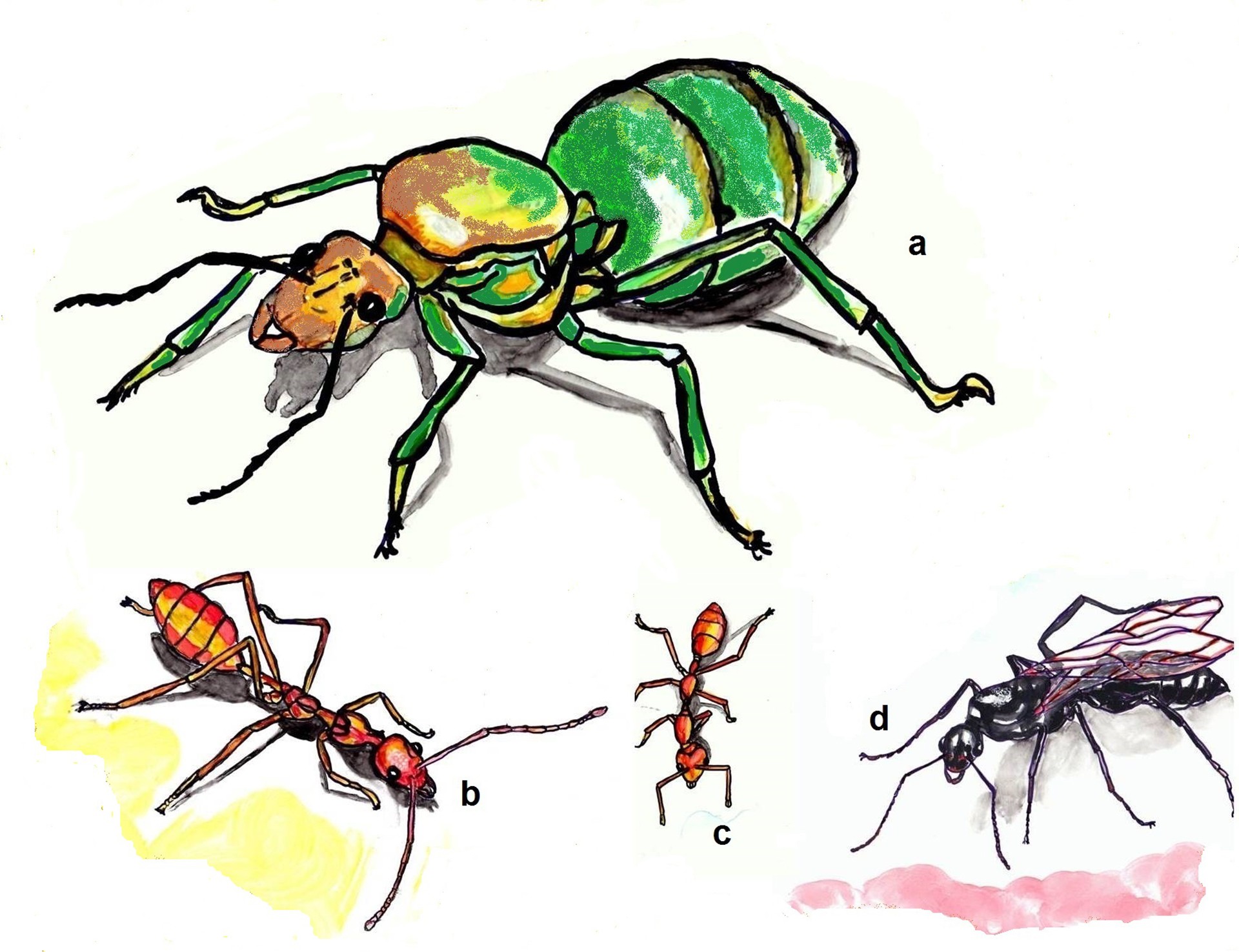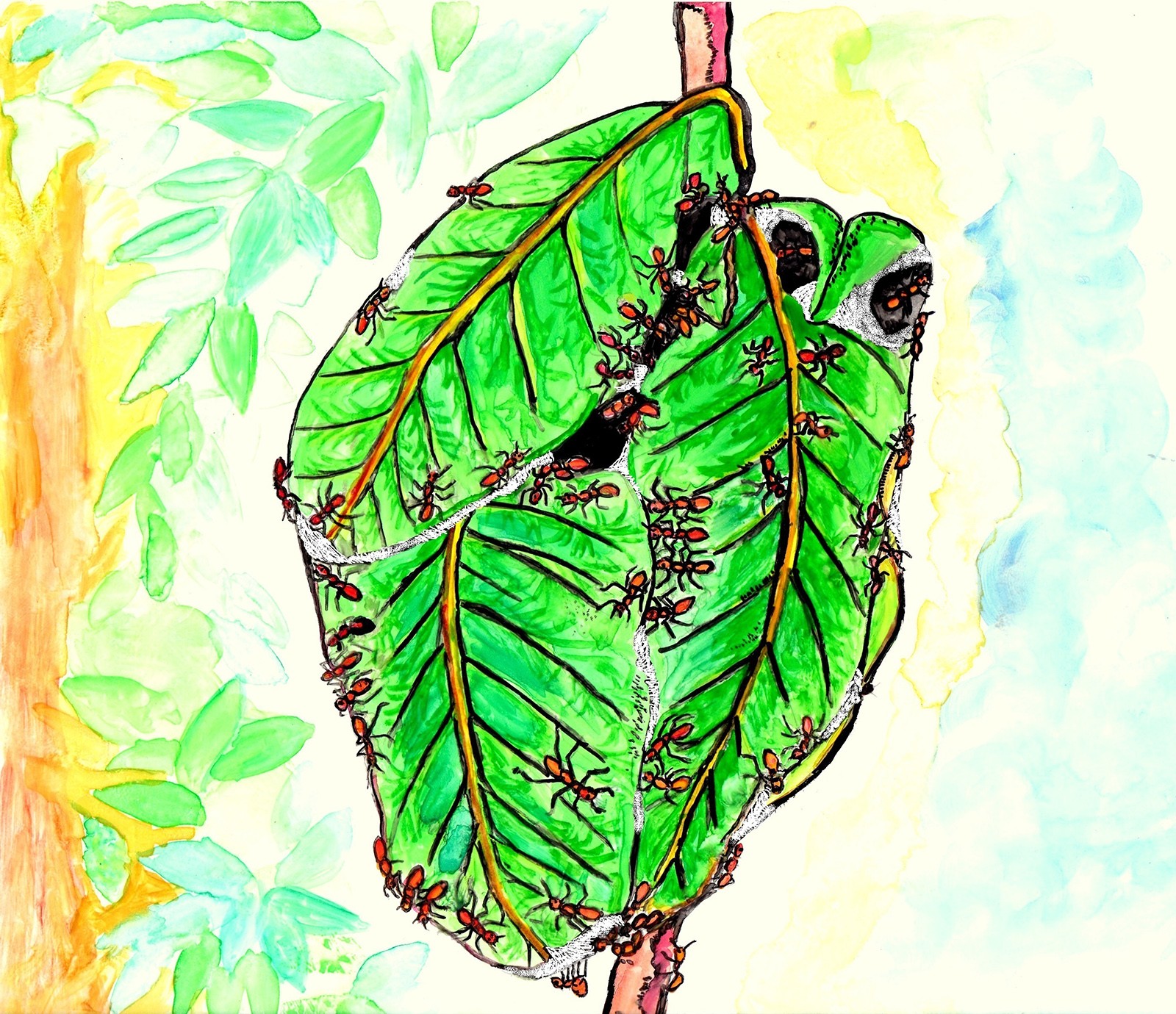Sure, there’s a wealth of flora and fauna to seek out in our sanctuaries, reserves and jungles. Wildlife enthusiasts will always be drawn to, well, wild spaces, but in the quiet time between each adventure, we should remember there’s a wide range of fascinating biodiversity to encounter in our cities, too. Through this new series, we encourage the Nature inFocus community to explore our urban biodiversity, to notice the often-overlooked creatures in our midst, and to appreciate their fascinating ecology and behaviour. Each story will focus on a single species representing different taxa, and will be illustrated by a different artist. We kick off the series with Weaver Ants. Look out for the next installment, all about Tortoise Beetles, next month.
Imagine a kingdom ruled by a queen, surrounded by servile workers who place her needs beyond everything else, and soldiers who fiercely defend their territory. A kingdom much like this exists in the arboreal world of your backyard.
That kingdom is made up of miniature, exclusively tree-dwelling creatures called Weaver Ants (Oecophylla smaragdina). Weaver ants are found in the tropical forests of peninsular India, southeast Asia and Australasia. Aptly named for their sophisticated tailoring skills, these ants live in nests made from leaves that they carefully stitch together into small tent-like parcels.
Like all ants, Weaver Ants too are social insects. They live in well-organised multi-generational colonies, divided into three castes, based on roles and responsibilities: one reproductive female, known as the queen, non-reproductive females known as workers, and reproductive males. Weaver Ant colonies are female-dominated; the large-bodied ‘major’ workers build nests, forage for food and protect the colony from enemies. The smaller-bodied ‘minor’ workers take care of the eggs and young ones. The males have very little role to play in this social structure, as they die soon after engaging in nuptial flights with the queen.
A Weaver Ant colony is usually spread across several trees, consisting of multiple nests and housing as many as half a million ants. For an active and expanding colony, nest building is a serious task. Nest-building is pursued more actively just before and during the rainy season, when new leaf flushes are aplenty.
Once a suitable tree branch has been scouted for, a set of leaves are manoeuvred into a globular shape by several major workers using graceful acrobatic movements. Another set of worker ants ferry larvae from existing nests to this spot. The worker ants shuttle the larvae back and forth across the arranged leaf stems, inducing them to secrete silky threads in tandem with the workers’ coordinated movements. That is how the leaves are woven into a nest, each of which is used for roughly four months.
A nest is composed of one or more compartments and usually serve multiple purposes. The queen is located in one nest and the eggs she lays are distributed by the workers to other nests within the colony. These act as nurseries, where ant eggs, larvae and pupae will be raised.
Compartments within some nests serve as retreat centres during predator attacks. Most nests located at the periphery of a colony act as outposts for guarding and surveillance. They are occupied by an older generation of major workers who are more experienced at detecting and dealing with threats.
A few nests are used to shelter beneficial insects such as scale insects and certain aphids. Although weaver ants feed on arthropods (insects, arachnids, crustaceans, etc), they also exhibit an interesting association with these ‘beneficial’ insects, which exude sweet secretions that are highly savoured by Weaver Ants. In return, these insects are protected from predators and have their surroundings kept clean by the ants.
Weaver Ants belong to a genus that has existed for 30 million years. Their connection to humans is also very old and dates back to the 4th century. Chinese farmers are known to have gathered and sold ant nests to guard citrus orchards – as the weaver ants would attack, kill and sometimes even feed on pests. All individuals within a colony have a distinct signature odour, and rely heavily on their sense of smell and taste to recognise their own colony-mates. Intruding insects, even members of neighbouring weaver ant colonies, are aggressively attacked.
Centuries ago, Chinese farmers would build artificial bamboo bridges between trees specifically to facilitate the movements of these ants within the orchard. This bio-control technique continues to be used successfully even today in citrus, cashew and mango plantations across Australia and southeast Asia. According to some estimates, farmers have saved up to half of their pesticide costs with help from weaver ants.
So the next time you peek into your wooded backyard, keep an eye out for the vast aerial empire created by Weaver Ants. It’s easy to spot their conspicuous leaf-nests within a canopy. But be careful not to wander too close: these ants have extremely strong mandibles, capable of inflicting a painful bite if alarmed. This is often followed by a direct spray of formic acid into the bite-wound that can cause severe discomfort.


